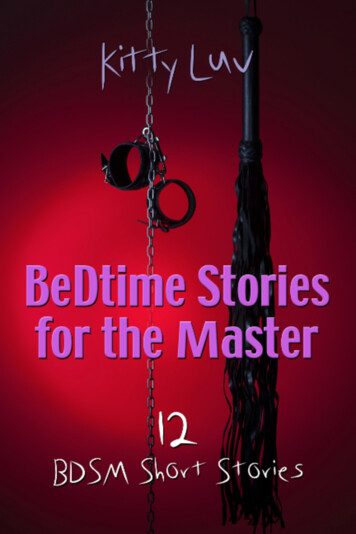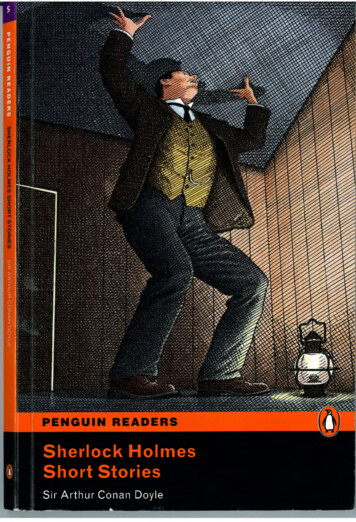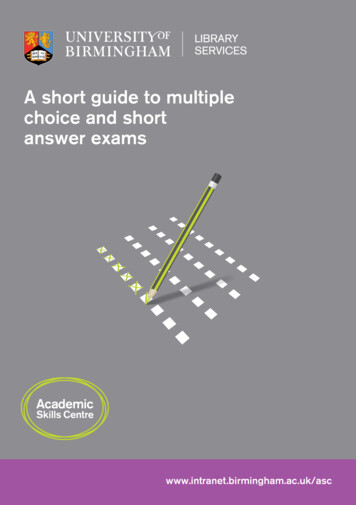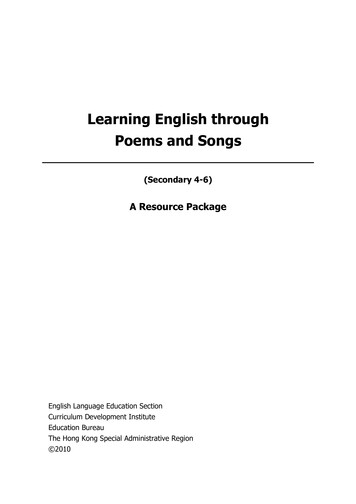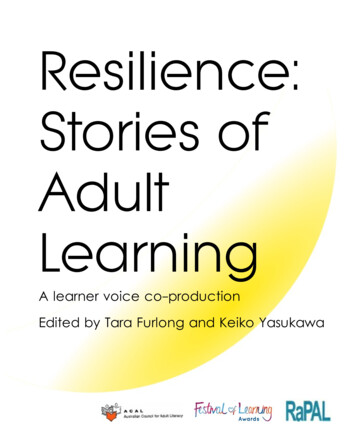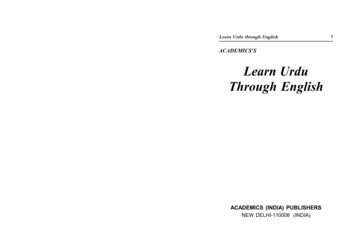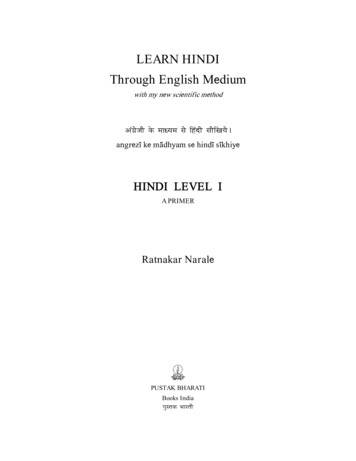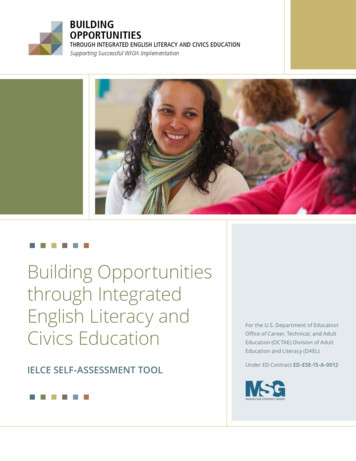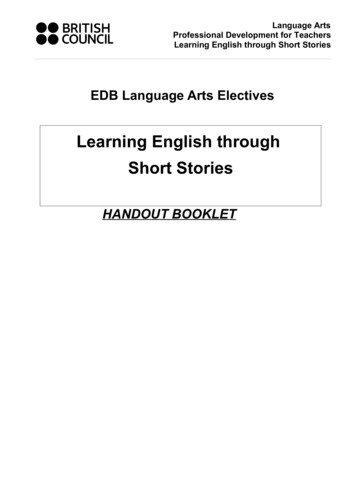
Transcription
Language ArtsProfessional Development for TeachersLearning English through Short StoriesEDB Language Arts ElectivesLearning English throughShort StoriesHANDOUT BOOKLET
Language ArtsProfessional Development for TeachersLearning English through Short StoriesThis handbook provides all the materials used in the training workshops as wellas many suggestions and additional resources to use with your students.ContentsIntroduction to the ModuleRelationship of Compulsory and Elective PartsAims, Objectives, Content and Assessing of the Short Story ModulePage 3Page 6Practical demonstrationsOpeningsCollaborative story buildingPage 13Page 18Teaching / Learning activitiesPage 221 Characterisation2 Helping students to read, understand and enjoy short stories3 The Element of Setting4 The Element of Dialogue5 Storytelling6 Stories with a Twist : Fractured Fairy TalesPage 23Page 32Page 41Page 50Page 57Page 64Noticing activitiesPage 72Resources for teaching short storiesPage 752 The British CouncilThe United Kingdom’s international organisation for educational opportunities and cultural relations. We are registered in England as a charity.
Language ArtsProfessional Development for TeachersLearning English through Short StoriesPart 1:Relationship of Compulsory and Elective PartsAims, Objectives, Content and Assessing of the Short StoryModuleBy the end of Part 1, you will have: Explored the relationship between the Compulsory and Elective parts of the NewSenior Secondary English Language CurriculumDiscussed the Short Story ModuleHad practical experience of working in groups in various activities detailed belowACTIVITY 1: The Proposed Changes to the NSS English Language Curriculum.In your groups turn over the ten strips one by one and discuss the statements about theproposed changes to the New Senior Secondary English Language Curriculum anddecide which ones are true.ACTIVITY 2: Aims, Objectives, Content and Assessing the Short Story ModuleYou will complete different tasks with other Workshop Participants to help you gather andprocess information about each aspect of the Short Story Module.3 The British CouncilThe United Kingdom’s international organisation for educational opportunities and cultural relations. We are registered in England as a charity.
Language ArtsProfessional Development for TeachersLearning English through Short StoriesThe Proposed Changes to the NSS English Language CurriculumRead the following statements anddecide if they are true or falseFalsTruee1.The Proposed New Senior Secondary English Language Curriculumconsists of two parts; the Compulsory Part and the Elective Part2. Equal lesson time should be allocated to the two parts3. Both the Compulsory and the Elective Parts include the learning ofEnglish Language in the Interpersonal, Knowledge and Experiencestrands.4. The Compulsory Part focuses on language input (a) language formsand function and b) vocabulary presented in a variety of text-types anddeveloping competence in the skills of Listening, Speaking, Reading andWriting.5. The modules in the Elective Part are categorised into two groups withthree modules each.6. The Elective Part reinforces different aspects of English languagelearning and should a) add variety to the English Language curriculum, b)broaden learners’ learning experience and c) cater for learners’ diverseneeds and interests.7. Students have to complete four of the proposed Elective modules – twofrom each group.8. The Elective modules enhance the further development of nine genericskills (collaboration skills, communication skills, creativity, critical thinkingskills, information technology skills, numeracy skills, problem-solving skills,self-management skills and study skills).9. The Proposed New Senior Secondary English Language Curriculum hasspecific language development strategies such as: a) developing thinkingskills, b) developing reference skills, c) developing information skills, d)developing enquiry skills, e) planning, managing and evaluating ownlearning, f) self- motivation and g) working with others.10.The development of positive attitudes should be provided in alllearning tasks.KEY to Activity 1 (True/False Activity about Proposed NSS English Language Curriculum)1The Proposed New Senior Secondary English Language Curriculum consists of twoparts; the Compulsory Part and the Elective Part.(True)4 The British CouncilThe United Kingdom’s international organisation for educational opportunities and cultural relations. We are registered in England as a charity.
Language ArtsProfessional Development for TeachersLearning English through Short Stories2Equal lesson time should be allocated to the two parts.(False)(75% (about 305 hours) to the Compulsory Part and 25% (about 100 hours) to theElective Part.)3Both the Compulsory and the Elective Parts include the learning of English Languagein the Interpersonal, Knowledge and Experience strands, and they both have thesame learning objectives.(True)4The Compulsory Part focuses on language input (a) language forms and functionand b) vocabulary presented in a variety of text-types and developing competence inthe skills of Listening, Speaking, Reading and Writing.(True)5The proposed modules in the Elective Part are categorised into two groups with threemodules each.(False)(True: There are two groups - Language Arts and Non-Language Arts but False as there arefour modules each. They are: a) Language Arts: Learning English through Drama /Learning English through Short Stories / Learning English through Poems and Songs /Learning English through Popular Culture b) Non-Language Arts: Learning English throughSports Communication / Learning English through Debating / Learning English throughSocial Issues / Learning English through Workplace Communication)6The Elective Part reinforces different aspects of English language learning andshould a) add variety to the English Language curriculum, b) broaden learners’learning experience and c) cater for learners’ diverse needs and interests. (True)7Students have to complete four of the proposed Elective modules – two from eachgroup.(False)(Students have to complete only three in total but one from each group)8The Elective modules have to enhance the further development of nine generic skills(collaboration skills, communication skills, creativity, critical thinking skills, informationtechnology skills, numeracy skills, problem-solving skills, self-management skills andstudy skills).(False)(The English Language Education KLA provides greater opportunities for the development ofsix of the generic skills - collaboration, communication, creativity, critical thinking,problem-solving and study skills)9The Proposed New Senior Secondary English Language Curriculum has specificlanguage development strategies such as: a) developing thinking skills,b) developing reference skills, c) developing information skills, d) developingenquiry skills, e) planning, managing and evaluating own learning, f) selfmotivation and g) working with others.(True)10The development of positive attitudes should be provided in all learning tasks.(It is an integral part of the curriculum)(True)5 The British CouncilThe United Kingdom’s international organisation for educational opportunities and cultural relations. We are registered in England as a charity.
Language ArtsProfessional Development for TeachersLearning English through Short StoriesGeneral Description of the Module: Learning English through Short StoriesThis module introduces learners to the world of short stories, encouraging them to read,write and tell them.Learners will be engaged in different activities which aim to developa) their understanding of the major features of short stories,b) their language skillsc) cultural awarenessd) critical thinking skills ande) creativity.At the end of the module learners will eithera) write their own story orb) develop a given story outline.Learning Targets of the ModuleTo develop learners’ ability toa) understand the major features of short stories (e.g. openings/closings, character,plot, twists)b) respond and give expression to the imaginative ideas and feelings expressed in shortstories through oral, written and performative means.c) understand how English works in short stories and apply this understanding to theirlearning and use of the language.Learning Objectives of the Modulea) To help learners to understand the concepts of narration, setting, character, themeand symbol, as well as to consider ways to create mood, and write good story usingopenings, closings and dialogue.6 The British CouncilThe United Kingdom’s international organisation for educational opportunities and cultural relations. We are registered in England as a charity.
Language ArtsProfessional Development for TeachersLearning English through Short Storiesb) To help learners to apply the concepts and techniques they have learned in their ownwriting.c) To enhance learners’ skills and interest in reading and appreciating short stories froma wide variety of sources.d) To help learners to talk about fiction in an informed way.e) To introduce learners to storytelling as an art form.Content of the ModuleIn Part 1, learners are introduced to the aims, design and content of the module. They willlearn to identify and understand the key features of a short story, and read short storieswith appreciation.In Part 2, learners read and write specific aspects of a short story such as setting,character, theme, dialogue, opening and closing. They will also start to write their ownstory for the module by gathering ideas and producing drafts.In Part 3, learners practise oral and story-telling skills by sharing a story of their own choicewith the class. They will finalise the draft for their module story and perform it to the class.Time Allocation of the ModuleIt is recommended that approximately a total of 50 periods be allocated to the teaching ofthis module. The suggested number of periods is based on the assumption that schools arerunning 40-minute periods. The breakdown for the three parts can be as follows:Part 19 periodsPart 221 periodsPart 320 periods7 The British CouncilThe United Kingdom’s international organisation for educational opportunities and cultural relations. We are registered in England as a charity.
Language ArtsProfessional Development for TeachersLearning English through Short StoriesAssessmentAssessment in the Short Stories module will focus on learners’ demonstration of their abilityto:a) understand concepts and techniques of short story writingb) apply this understanding to create short examplesc) produce a written short storyd) comment helpfully on the work of otherse) tell or perform stories orallyf) read and comment on a number of short storiesA range of activities will be used for assessing learner performance, includinga) short pieces of writingb) an end-of-course short storyc) oral performances8 The British CouncilThe United Kingdom’s international organisation for educational opportunities and cultural relations. We are registered in England as a charity.
Language ArtsProfessional Development for TeachersLearning English through Short StoriesMatch the type of short story with the extracts1. Horror Storya) She waved her magic wand, and suddenlythe frog turned into a handsome prince.2. Love Storyb) He woke to see a shadowy figure in medievalclothes walking across the room. He went coldand tried to call out, but could not speak3. Detective Storyc) “Darling!” she whispered. “I’ve waited all mylife for you”.4. Ghost Storyd) The spaceship lowered itself onto this red,powdery planet which appeared to have nopeople, no animals and no oxygen but whichhad a series of underground cities.5. Fairy Storye) The sheep was praising the wolf for hiscompassion when a passing fox warned “Thecompassionate wolf is not what he appears”.6. Fablef) Watson looked first at Holmes, and then at thegun on the table. “I know who did it”, he saidcalmly.7. Science Fictiong) They set off on their way at dawn. The caveswere not far away but the journey seemed longby horseback.8. Adventure Storyh) Slowly, he opened the door and looked insidethe room. The portrait on the wall had changed.It was now a mass of tangled branches andblood. He let out a loud scream and ran downthe stairs.9 The British CouncilThe United Kingdom’s international organisation for educational opportunities and cultural relations. We are registered in England as a charity.
Language ArtsProfessional Development for TeachersLearning English through Short StoriesReflection:1. What helped you to match the story types and the extracts?2. Which story types might not be appropriate for use with your students? Why not?3. Which vocabulary and language structures might to be central to students’ readingcomprehension of (and ability to write) each story type?Story TypeHorror StoryLexisStructuresAdverbs of movementNarrative tensesLove StoryDetective StoryGhost StoryFairy StoryFableScience FictionAdventure Story10 The British CouncilThe United Kingdom’s international organisation for educational opportunities and cultural relations. We are registered in England as a charity.
Language ArtsProfessional Development for TeachersLearning English through Short StoriesFeatures of short stories – Matching ActivityOpeningthe first few sentences, which usually arouse curiosity, pull the readerin and carry compressed information in short storiesExpositionat the start of the story, the setting, situation and main characters upto now are introduced (though not used as much in short stories as innovels)Characterisationthe process of creating and developing charactersPlota planned, logical series of events having a beginning, middle, andend. The short story usually has one plot so it can be read in onesittingDialoguespeech used for moving the story forward, though some dialogue canbe redundantNarrativedescribes a sequence of events.Symbolan enhance
1.The Proposed New Senior Secondary English Language Curriculum consists of two parts; the Compulsory Part and the Elective Part 2. Equal lesson time should be allocated to the two parts 3. Both the Compulsory and the Elective Parts include the learning of English Language in the Interpersonal, Knowledge and Experience strands. 4.

